Foresight Institute Feynman Prize in Nanotechnology
The Feynman Prize in Nanotechnology is an award given by the Foresight Institute every year for significant advancements in nanotechnology. It is named in honor of physicist Richard Feynman, whose 1959 talk There's Plenty of Room at the Bottom is considered to have inspired the beginning of the field of nanotechnology.
The prize was established "to recognize researchers whose recent work has most advanced the field toward the achievement of Feynman's vision for nanotechnology: molecular manufacturing, the construction of atomically precise products through the use of molecular machine systems."[1]
The Foresight Institute also offers the Feynman Grand Prize, a $250,000 award to the first persons to create both a nanoscale robotic arm capable of precise positional control, and a nanoscale 8-bit adder, conforming to given specifications. The Grand Prize is intended to stimulate the field of molecular nanotechnology in the same way as similar historical prizes such as the Longitude prize, Orteig Prize, Kremer prize, Ansari X Prize, and two prizes that were offered by Richard Feynman himself as challenges during his 1959 There's Plenty of Room at the Bottom talk.[2]
The Foresight Institute has offered a number of additional awards as well. The Prize in Communication for journalism and outreach efforts which promote public understanding of molecular nanotechnology was awarded from 2000 to 2007, and a Government Prize to recognize government officials was awarded in 2005. A Distinguished Student Award for graduate and undergraduate students was awarded from 1997 to 2007, and resumed in 2012.[3][4]
Feynman prize winners
The prize was first given in 1993. Before 1997, one prize was given biennially. From 1997 on, two prizes were given each year in Theory and Experimental categories.
Single prize
Experimental category
| Year |
Laureate |
Institution |
Rationale |
| 1997 |
|
James K. Gimzewski |
IBM Zurich Research Laboratory |
"for work using scanning probe microscopes to manipulate molecules"[7] |
|
Reto Schlittler |
|
Christian Joachim |
CEMES/French National Centre for Scientific Research |
| 1998 |
|
M. Reza Ghadiri |
Scripps Research Institute |
"for groundbreaking work in constructing molecular structures through the use of self-organization, the same forces used to assemble the molecular machine systems found in nature"[8] |
| 1999 |
|
Phaedon Avouris |
IBM Watson Research Center |
"[for] the development of carbon nanotubes for potential computing device applications"[9] |
| 2000 |
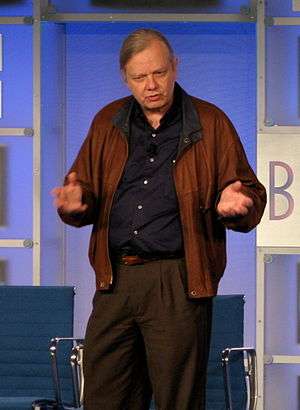 |
R. Stanley Williams |
HP Labs |
"for building a molecular switch, a major step toward their long-term goal of building entire memory chips that are just a hundred nanometers wide"[10] |
|
Philip Kuekes |
|
James R. Heath |
University of California, Los Angeles |
| 2001 |
|
Charles M. Lieber |
Harvard University |
"for his pioneering experimental work in molecular nanotechnology which included seminal contributions to the synthesis and characterization of the unique physical properties of carbon nanotubes and nanowires"[11] |
| 2002 |
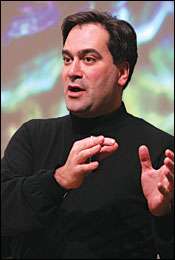 |
Chad Mirkin |
Northwestern University |
"for opening up new possibilities for the fabrication of molecular machine systems by selectively functionalizing nanoparticles and surfaces, particularly with DNA, enabling the self-assembly of new structures which move us closer to the goal of molecular manufacturing"[12] |
| 2003 |
|
Carlo Montemagno |
University of California, Los Angeles |
"for his pioneering research into methods of integrating single molecule biological motors with nano-scale silicon devices, which opens up new possibilities for nanomachines"[13] |
| 2004 |
|
Homme Hellinga |
Duke University |
"for his achievement in the engineering of atomically precise devices capable of precise manipulation of other molecular structures"[14] |
| 2005 |
|
Christian Schafmeister |
University of Pittsburgh |
"for his work in developing a novel technology synthesizing macromolecules of intermediate sizes (between 1000 and 10,000 Daltons) with designed shapes and functions"[15] |
| 2006 |
|
Erik Winfree |
California Institute of Technology |
"for their work demonstrating that DNA tiles can be designed to form crystalline nanotubes that exhibit a stiffness greater than the biological protein nanofilament actin, [and for having] established that algorithmic self-assembly could work well enough to generate non-trivial non-periodic patterns"[16] |
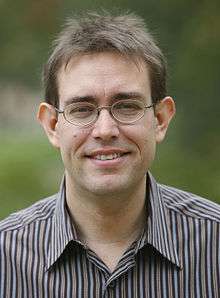 |
Paul W. K. Rothemund |
| 2007 |
|
J. Fraser Stoddart |
University of California, Los Angeles |
"[for having] pioneered the synthesis and assembly of unique active molecular machines for manufacturing into practical nanoscale devices"[17] |
| 2008 |
 |
James Tour |
Rice University |
"for the Synthesis of Nanocars... and other molecular machines [which] is providing critical insight in investigations of bottom-up molecular manufacturing"[18] |
| 2009 |
|
Yoshiaki Sugimoto |
Osaka University |
"in recognition of their pioneering experimental demonstrations of mechanosynthesis, specifically the use of atomic resolution dynamic force microscopy — also known as non-contact atomic force microscopy (NC-AFM) — for vertical and lateral manipulation of single atoms on semiconductor surfaces"[19] |
|
Masayuki Abe |
|
Oscar Custance |
Japanese National Institute for Materials Science |
| 2010 |
|
Masakazu Aono |
MANA Center, Japanese National Institute for Materials Science |
"in recognition of his pioneering and continuing work, including research into the manipulation of atoms, the multiprobe STM and AFM, the atomic switch, and single-molecule-level chemical control including ultradense molecular data storage and molecular wiring; and his inspiration of an entire generation of researchers who have made their own ground-breaking contributions to nanotechnology"[1] |
| 2011 |
|
Leonhard Grill |
Fritz Haber Institute of the Max Planck Society |
"in recognition of his pioneering and continuing work on manipulating and structuring functional matter at the atomic scale"[20] |
| 2012 |
|
Gerhard Meyer |
IBM Zurich Research Laboratory |
"[for] their remarkable experiments advancing the frontiers of scanning probe microscopy. They were the first to produce images of molecular orbitals and charges detailed enough to identify the structure of individual molecules, as well as metal-molecule complexes. They have also been able to precisely make and break individual chemical bonds."[21] |
|
Leo Gross |
|
Jascha Repp |
| 2013 |
|
Alexander Zettl |
University of California, Berkeley |
"[for] exceptional work in the fabrication of nanoscale electromechanical systems (NEMS), spanning multiple decades and including carbon nanotube-based bearings, actuators, and sensors brought to fruition with cutting-edge nanoscale engineering"[22] |
| 2014 |
|
Joseph W. Lyding |
University of Illinois at Urbana–Champaign |
"[for being] a pioneer in the development of scanning tunneling microscope (STM) technology and particularly hydrogen depassivation lithography"[23] |
Theory category
| Year |
Laureate |
Institution |
Rationale |
| 1997 |
|
Charles Bauschlicher |
NASA Ames Research Center |
"for work in computational nanotechnology"[7] |
|
Stephen Barnard |
|
Creon Levit |
|
Glenn Deardorff |
|
Al Globus |
|
Jie Han |
|
Richard Jaffe |
|
Alessandra Ricca |
|
Marzio Rosi |
|
Deepak Srivastava |
|
H. Thuemmel |
| 1998 |
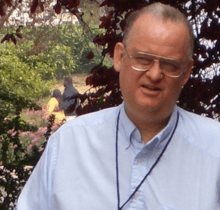 |
Ralph C. Merkle |
Zyvex |
"for their computational modeling of molecular tools for atomically-precise chemical reactions"[8] |
|
Stephen Walch |
ELORET Corporation/NASA Ames Research Center |
| 1999 |
|
William A. Goddard III |
California Institute of Technology |
"for their work in modeling the operation of molecular machine designs"[9] |
|
Tahir Cagin |
|
Yue Qi |
| 2000 |
|
Uzi Landman |
Georgia Institute of Technology |
"for his pioneering work in computational materials science for nanostructures"[10] |
| 2001 |
 |
Mark A. Ratner |
Northwestern University |
"[for being] a theorist whose work has made major contributions to the development and success of nanometer-scale electronic devices"[11] |
| 2002 |
|
Don Brenner |
North Carolina State University |
"for fundamental advances in our ability to model molecular machine systems, and for the design and analysis of components likely to be important in future molecular manufacturing systems"[12] |
| 2003 |
|
Marvin L. Cohen |
University of California, Berkeley |
"for their contributions to the understanding of the behavior of materials"[13] |
|
Steven G. Louie |
| 2004 |
 |
David Baker |
University of Washington |
"for their development of RosettaDesign, a program that has a high success rate in designing stable protein structures with a specified backbone folding structure"[14] |
|
Brian Kuhlman |
University of North Carolina, Chapel Hill |
| 2005 |
|
Christian Joachim |
French National Centre for Scientific Research |
"for developing theoretical tools and establishing the principles for design of a wide variety of single molecular functional nanomachines"[15] |
| 2006 |
|
Erik Winfree |
California Institute of Technology |
"for their 'Theory in Molecular Computation and Algorithmic Self-assembly' research... based on their demonstration of methods for universal computation with DNA, including using DNA tiles to simulate cellular automata"[16] |
 |
Paul W. K. Rothemund |
| 2007 |
|
David A. Leigh |
University of Edinburgh |
"[for] the design and synthesis of artificial molecular motors and machines from first principles and... the construction of molecular machine systems that function in the realm of Brownian motion"[17] |
| 2008 |
|
George C. Schatz |
Northwestern University |
"first for sophisticated modeling and optimization of the dip pen nanolithography method of nanofabrication, and second, for his explanation of plasmon effects in metallic nanodots"[18] |
| 2009 |
|
Robert A. Freitas Jr. |
Institute for Molecular Manufacturing |
"in recognition of his pioneering theoretical work in mechanosynthesis in which he proposed specific molecular tools and analyzed them using ab initio quantum chemistry to validate their ability to build complex molecular structures, [and] also his previous work in systems design of molecular machines, including replicating molecular manufacturing systems, which should eventually be able to make large atomically precise products economically, and the design of medical nanodevices, which should eventually revolutionize medicine"[19] |
| 2010 |
|
Gustavo E. Scuseria |
Rice University |
"for his development of quantum mechanical methods and computational programs that make it possible to carry out accurate theoretical predictions of molecules and solids, and their application to the chemical and electronic properties of carbon nanostructures"[1] |
| 2011 |
|
Raymond Astumian |
University of Maine |
"for his contributions to the understanding of Brownian motion and its use to power molecular motors and other functional mechanisms at the atomic scale"[20] |
| 2012 |
|
David Soloveichik |
University of California, San Francisco |
"for his general theory of DNA displacement cascades. He has shown that systems of DNA molecules can be designed with arbitrary dynamic behavior. In particular, he has shown that they are Turing-complete, and so can be made to run any general-purpose computer program."[21] |
| 2013 |
|
David Beratan |
Duke University |
"[for the] development of theoretical approaches to understand the function of complex molecular and macromolecular assemblies and machines."[22] |
| 2014 |
|
Amanda Barnard |
Australian Commonwealth Scientific and Industrial Research Organisation |
"[for] spearhead[ing] understanding of the structure and stability of carbon nanostructures, and the role that shape plays in establishing the properties and interactions under different conditions"[23] |
Related prizes
Foresight Institute Prize in Communication
| Year |
Laureate |
Institution |
Rationale |
| 2000 |
|
Ron Dagani |
American Chemical Society |
"for extensive coverage of nanotechnology and nanotechnology-related research over the past three years in Chemical & Engineering News"[24] |
| 2001 |
|
Ivan Abel Amato |
Science Service |
"[for] work for Science News and Science magazines... [including] orchestrated a special series of essays, called 'Pathways of Discovery'"[25] |
| 2002 |
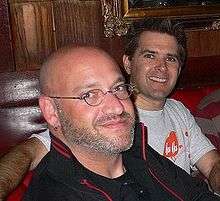 |
David Pescovitz |
University of California, Berkeley |
"[for work as] a columnist with Small Times, a magazine covering nanotech developments"[26] |
| 2003 |
|
Tim Harper |
Cientifica |
"for educating the nanotechnology community about the long-term potential of molecular nanotechnology... via their electronic newsletter, TNT Weekly, and industry survey, The Nanotechnology Opportunity Report"[27] |
|
Paul Holister |
| 2004 |
|
Howard Lovy |
NanoBot Blog |
"[for having] taken a leading role in educating the nanotechnology community about the long-term potential of molecular nanotechnology"[28] |
| 2005 |
|
Rocky Rawstern |
Nanotechnology Now |
"[for] provid[ing] a digital forum where accurate information about the transformative aspects of science, technology and engineering is available"[29] |
| 2006 |
|
J. Storrs Hall |
none |
"for his recently published book Nanofuture: What's Next For Nanotechnology"[30] |
| 2007 |
|
Robert Freitas |
Institute for Molecular Manufacturing |
"for [writing] Nanomedicine, the definitive book on the medical applications of molecular nanotechnology... and Kinematic Self-Replicating Machines, the foundational description of system architectures for molecular nanotechnology"[31] |
Foresight Institute Government Prize
| Year |
Laureate |
Institution |
Rationale |
| 2005 |
 |
Mike Honda |
United States House of Representatives |
"[for being] one of the key legislators that initiated the Nanotechnology Research and Development Act signed by President Bush in 2003... [and] the driver of the Nanomanufacturing Investment Act (HR1491)"[32] |
See also
References
External links









